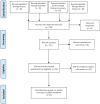Estimating the Number of Civilian Casualties in Modern Armed Conflicts-A Systematic Review
- PMID: 34778192
- PMCID: PMC8581199
- DOI: 10.3389/fpubh.2021.765261
Estimating the Number of Civilian Casualties in Modern Armed Conflicts-A Systematic Review
Abstract
Objective: To examine the possibility of estimating the number of civilian casualties in modern armed conflicts. Methods: A systematic review was conducted following the Preferred Reporting Items for Systematic Reviews and Meta-Analyses guidelines, using PubMed, Scopus, and Web of Science search engines. The outcome was analyzed using a qualitative inductive thematic analysis. The scientific evidence of selected article was assessed, using the Health Evidence Quality Assessment Tool. Findings: The review of 66 included articles in this study indicates that with an increasing number of public health emergencies and the lack of vital elements of life such as water and food, emerging armed conflicts seem to be inevitable. In contrast to military-led cross-border traditional wars, modern armed conflicts affect internally on local communities and take civilian lives. Consequently, the measures and tools used in traditional military-led cross-border wars to adequately tally wounded and dead for many decades under the mandates of the International Humanitarian Law, is insufficient for modern warfare. While casualty counting during modern conflicts is deficient due to organizational, political or strategic reasons, the international organizations responsible for collecting such data (the International Federation of Red Cross and Red Crescent and International Institute of Humanitarian Law) face difficulties to access the conflict scene, resulting in under-reported, unreliable or no-reported data. Conclusion: There are challenges in estimating and counting the number of civilian casualties in modern warfare. Although the global need for such data is evident, the risks and barriers to obtaining such data should be recognized, and the need for new international involvement in future armed conflicts should be emphasized.
Keywords: armed conflicts; casualties; civilians; estimation; humanitarian law; tool.
Copyright © 2021 Khorram-Manesh, Burkle, Goniewicz and Robinson.
Conflict of interest statement
The authors declare that the research was conducted in the absence of any commercial or financial relationships that could be construed as a potential conflict of interest.
Figures
Similar articles
-
Review of Military Casualties in Modern Conflicts-The Re-emergence of Casualties From Armored Warfare.Mil Med. 2022 Mar 28;187(3-4):e313-e321. doi: 10.1093/milmed/usab108. Mil Med. 2022. PMID: 33742659 Free PMC article. Review.
-
[Protection of medical personnel in contemporary armed conflicts].Wiad Lek. 2016;69(2 Pt 2):280-4. Wiad Lek. 2016. PMID: 27487549 Polish.
-
Fighting with words: humanitarian security and the changing role of law in contemporary armed conflict.Disasters. 2023 Oct;47(4):870-890. doi: 10.1111/disa.12580. Epub 2023 May 1. Disasters. 2023. PMID: 37036045
-
Revisiting the Battle of Solferino: The Worsening Plight of Civilian Casualties in War and Conflict.Disaster Med Public Health Prep. 2019 Dec;13(5-6):837-841. doi: 10.1017/dmp.2019.77. Disaster Med Public Health Prep. 2019. PMID: 31397655
-
The right to health, public health and COVID-19: a discourse on the importance of the enforcement of humanitarian and human rights law in conflict settings for the future management of zoonotic pandemic diseases.Public Health. 2021 Mar;192:3-7. doi: 10.1016/j.puhe.2021.01.001. Epub 2021 Jan 16. Public Health. 2021. PMID: 33601306 Free PMC article. Review.
Cited by
-
Impact of war-associated factors on spread of sexually transmitted infections: a systemic review.Front Public Health. 2024 Apr 5;12:1366600. doi: 10.3389/fpubh.2024.1366600. eCollection 2024. Front Public Health. 2024. PMID: 38645454 Free PMC article.
-
The Casualties of War: An Excess Mortality Estimate of Lives Lost in the 2020 Nagorno-Karabakh Conflict.Popul Res Policy Rev. 2023;42(3):41. doi: 10.1007/s11113-023-09790-2. Epub 2023 May 10. Popul Res Policy Rev. 2023. PMID: 37193053 Free PMC article.
-
Acceptance and commitment therapy for enhancing mental health in military personnel: A comprehensive review and meta-analysis.World J Psychiatry. 2025 Mar 19;15(3):100959. doi: 10.5498/wjp.v15.i3.100959. eCollection 2025 Mar 19. World J Psychiatry. 2025. PMID: 40110015 Free PMC article.
-
Exploring the health consequences of armed conflict: the perspective of Northeast Ethiopia, 2022: a qualitative study.BMC Public Health. 2023 Oct 24;23(1):2078. doi: 10.1186/s12889-023-16983-z. BMC Public Health. 2023. PMID: 37875885 Free PMC article.
-
Achieving Universal Health Coverage in Low- and Middle-Income Countries: Challenges for Policy Post-Pandemic and Beyond.Risk Manag Healthc Policy. 2023 Apr 6;16:607-621. doi: 10.2147/RMHP.S366759. eCollection 2023. Risk Manag Healthc Policy. 2023. PMID: 37050920 Free PMC article. Review.
References
-
- Ogar JN, Ogar TE. An appraisal of globalization and its history. Multidiscipline Res J. (2019) 11:182–95. Available online at: https://www.proquest.com/scholarly-journals/appraisal-globalization-hist...
-
- Lerche III CO . The Conflicts of Globalization. Int J Peace Stud. (1998) 3. Available online at: https://www.gmu.edu/programs/icar/ijps/vol3_1/learch.htm (accessed August 26, 2021).
-
- Smith RP. The economic costs of military conflicts. J Peace Res. (2013) 51:245–56. 10.1177/0022343313496595 - DOI
-
- Dumouchel P. The Ambivalence of Scarcity and Other Essays. Michigan State University Press (2014). Available online at: http://ejournalcentral.proquest.com/lib/uu/detail.action?docID=3338367 (accessed August 26, 2021).
Publication types
MeSH terms
LinkOut - more resources
Full Text Sources
Medical


